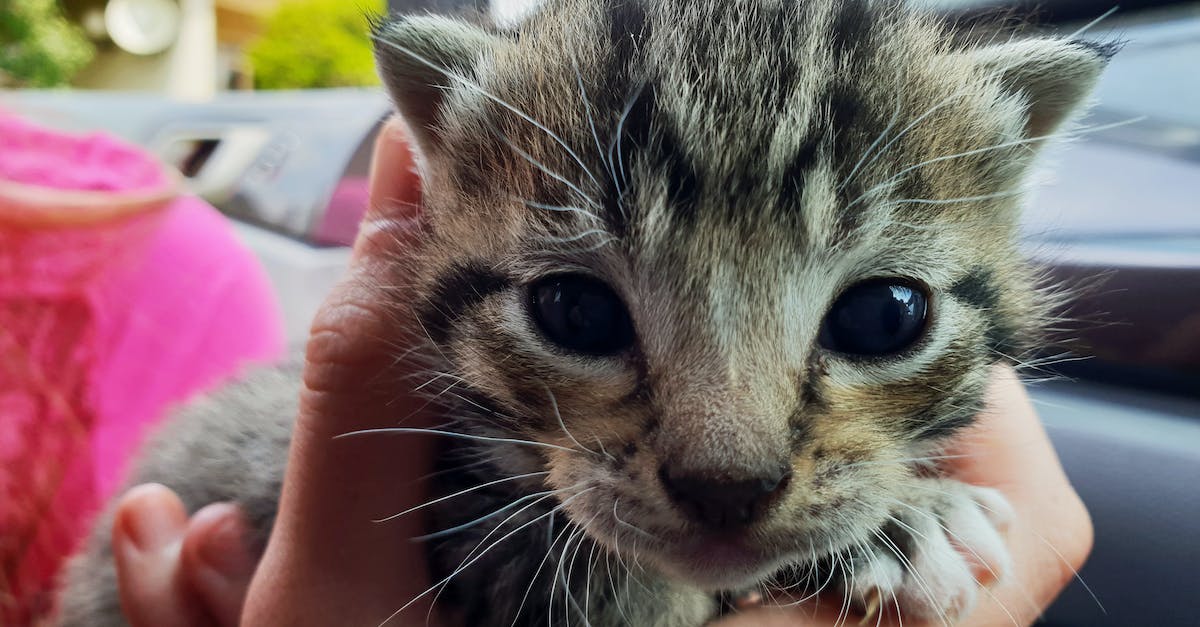Business
Introducing a New Cat to Your Feline Friend: A Step-by-Step Guide
Discover effective techniques for introducing a new feline friend to your resident cat in this informative article. Learn how to create a stress-free environment, use pheromone products, and gradually introduce the two cats. Overcome challenges like aggression, fear, and territorial behavior with practical strategies. Patience, consistency, and monitoring are key to a successful cat introduction.
Published
1 year agoon

Bringing a new cat into your home can be an exciting and rewarding experience. However, introducing a new feline friend to your resident cat can sometimes be a bit challenging. As a seasoned cat owner, I’ve faced this situation before and I’m here to share some valuable tips on how to successfully introduce a new cat to your furry companion.
In this article, I’ll guide you through the step-by-step process of introducing a new cat to your cat, ensuring a smooth transition and a harmonious coexistence. From creating a safe and comfortable environment to gradual introductions, I’ll provide you with practical advice based on my own experiences and expert knowledge. So, if you’re ready to embark on this journey of feline friendship, let’s dive in and learn how to make the introduction process a purrfect success.
Creating a Safe and Comfortable Environment
When introducing a new cat to your resident cat, it’s crucial to create a safe and comfortable environment for both feline friends. This helps to reduce stress and promotes a smoother transition. Here are some key steps I recommend to ensure a positive introduction:
- Prepare a separate space: Before bringing your new cat home, set up a separate room where they can stay initially. This allows both cats to adjust to each other’s scent and gradually get used to the idea of having a new housemate.
- Provide essential resources: Make sure each cat has their own food and water bowls, litter box, and resting areas. Cats are territorial animals, and having their separate resources helps them feel secure and prevents unnecessary conflicts.
- Use pheromone products: Consider using synthetic pheromones, such as Feliway, to create a calming environment. These products mimic natural feline pheromones and can help reduce tension and anxiety during the introduction process.
- Exchange scents: To familiarize the cats with each other’s scent, rub a soft cloth or towel on one cat and then place it near the other cat’s sleeping area. This helps them become familiar with each other’s scent and promotes positive associations.
- Gradually introduce through scent: Once the cats are comfortable with each other’s scents, you can start using a technique called scent swapping. Rub a cloth on one cat and then transfer it to the other cat’s space. This helps them get accustomed to each other’s smell without direct physical contact.
- Supervised interactions: When you feel both cats are ready for actual face-to-face interactions, do so under your direct supervision. Start with short, supervised sessions and gradually increase the length of their interactions. Be prepared to intervene if any signs of aggression or excessive fear are displayed.
Remember to be patient throughout the process and allow the cats to set their own pace. It’s normal for them to take some time to adjust and establish their own hierarchy. By creating a safe and comfortable environment, you’ll be setting the foundation for a positive relationship between your new and resident cats.
Preparing for the Introduction
When introducing a new cat to your resident cat, it’s essential to take certain steps to ensure a smooth and stress-free process. Preparing for the introduction can greatly increase the chances of the cats forming a positive relationship from the beginning. Here are a few key things to consider:
- Create a Separate Space: Before bringing the new cat home, set up a separate room or area where they can stay initially. This will provide a safe and comfortable space for the new cat to adjust without feeling overwhelmed. Make sure this space has all the essentials, such as a litter box, food and water bowls, toys, and a cozy bed.
- Provide Essential Resources: Each cat should have their own set of resources to avoid competition and potential conflicts. It’s important to have separate litter boxes, food and water bowls, and toys for each cat. This will help prevent any territorial disputes and allow each cat to establish their own space within the household.
- Use Pheromone Products: Consider using pheromone products, such as Feliway, to help create a calming environment for both cats. These products mimic the natural pheromones that cats release when they feel safe and secure. By using them in the new cat’s separate space as well as throughout the house, it can help reduce stress and anxiety during the introduction process.
- Exchange Scents: Before the actual introduction takes place, it’s beneficial to exchange scents between the cats. Rub a soft cloth or towel on one cat and then place it in the other cat’s space. This will allow them to become familiar with each other’s scent, which is an important part of the introduction process.
Remember, introducing a new cat to your resident cat is a gradual process. It’s important to remain patient and allow the cats to set their own pace in establishing a positive relationship. By following these preparation steps, you can help create a calm and welcoming environment for both cats, increasing the chances of a successful introduction.
Gradual Introductions
When it comes to introducing a new cat to your current cat, taking things slowly is crucial. Cats are territorial animals by nature, and they may feel threatened or anxious when faced with a new feline in their space. To ensure a smooth transition, it’s important to follow a gradual introduction process.
Here are a few guidelines to help you with the gradual introductions:
- Separate Spaces: Start by setting up a separate space for the new cat. This will allow both cats to get used to each other’s presence without direct contact. Provide the new cat with all the necessary resources, such as food, water, litter box, and comfortable bedding.
- Scent Exchange: To help the cats become familiar with each other’s scent, you can try rubbing a cloth or towel on one cat and then placing it near the other cat. This will help them get used to each other’s scent before they meet face-to-face.
- Feeding Near Each Other: Gradually start feeding the cats on opposite sides of a closed door. This will allow them to associate positive experiences, like mealtime, with each other’s presence. Over time, you can move the food bowls closer to the door to help them become more comfortable.
- Visual Introduction: Once the cats seem comfortable with each other’s scent and presence, it’s time for a visual introduction. You can use a baby gate or crack the door open slightly, allowing them to see each other without direct access. Be sure to supervise the interaction to ensure both cats’ safety.
- Supervised Contact: When the cats appear relaxed and comfortable with the visual introduction, you can start supervised physical interactions. Gradually increase the duration of these sessions over time, but always monitor their behavior to ensure that things remain calm.
Remember, patience is key during this process. Each cat will have their own unique personality and may require more or less time to adjust to the new addition. By taking things slowly and allowing the cats to set their own pace, you are more likely to establish a positive relationship between them.
Continue reading to discover additional tips and strategies for a successful cat introduction.
Supervising the Interactions
Introducing a new cat to a resident cat can be a delicate process. Once you have followed the initial steps of preparing a separate space, exchanging scents, and conducting visual introductions, it’s time to move on to supervised physical interactions. This phase is crucial for observing and guiding the cats’ behavior in a controlled environment.
Here are some guidelines for supervising the interactions between your new cat and resident cat:
1. Gradual introductions: Take small, incremental steps during the physical introduction phase. Start by allowing the cats to see each other through a screen or a cracked door. Gradually increase the amount of time they spend in each other’s presence, always closely monitoring their behavior.
2. Controlled environments: Initially, it is important to supervise the cats’ interactions in a controlled space, neutral to both cats. Consider using a large, secure room with no hiding spots to ensure their behavior remains visible.
3. Neutral territory: To avoid territorial disputes, try introducing both cats in neutral territory rather than their designated spaces. This can reduce the likelihood of aggression or fear-based behavior.
4. Separate food and water bowls: As the cats become more comfortable with each other’s presence, you can start placing their food and water bowls closer together. Make sure to monitor their reactions and adjust the distance accordingly. If any signs of stress or aggression arise, separate the bowls once again.
5. Redirecting negative behavior: Keep a close eye on the cats’ interactions and be prepared to intervene if any negative behavior occurs. This may include hissing, growling, or swatting. Redirect their attention by using toys or treats, and provide positive reinforcement for calm and friendly behavior.
Remember, every cat is unique, and the introduction process may take longer or shorter depending on their individual personalities and experiences. Be patient and allow them to set their own pace. Rushing the interactions can lead to stress and setbacks. By supervising and guiding their interactions in a controlled environment, you can continue to foster a positive relationship between your new cat and resident cat without causing undue stress or friction.
Stay tuned for the next section where I’ll discuss the importance of consistency and continued monitoring during the introduction process.
Addressing Challenges and Issues
Introducing a new cat to your resident cat can sometimes come with challenges and issues that need to be addressed. It’s important to recognize that each cat is unique and may have their own individual reactions and adjustments to the new arrival. Here are some common challenges you may encounter and how to address them:
1. Aggression or Territorial Behavior
Aggression or territorial behavior is a common challenge when introducing a new cat. It’s important to remember that cats are naturally territorial animals, and the presence of a new cat can disrupt their established territory. To address this issue:
- Keep the cats separated initially: Start by keeping the cats in separate rooms and gradually introduce them to each other’s scents through scent swapping.
- Provide separate resources: Make sure each cat has their own food and water bowls, litter boxes, and resting areas to reduce competition and potential conflicts.
- Use positive reinforcement: Reward both cats with treats and praise when they display calm and friendly behavior towards each other.
2. Fear or Anxiety
Fear and anxiety can occur in both the new cat and the resident cat during the introduction process. To help alleviate their stress and create a more positive environment:
- Create a safe space: Provide hiding spots, comfortable bedding, and vertical spaces for both cats to feel secure.
- Use pheromone products: Consider using pheromone diffusers or sprays that mimic the calming scents of mother cats to help reduce anxiety.
- Maintain a predictable routine: Stick to a consistent schedule for feeding, playtime, and interactions to establish a sense of normalcy for both cats.
3. Redirecting Negative Behavior
Sometimes, cats may display negative behaviors during the introduction process, such as hissing, growling, or swatting. It’s important to redirect these behaviors in a positive way to prevent escalation:
- Distract with toys: Provide interactive toys or puzzle feeders to redirect their attention and energy towards positive activities.
- Use positive reinforcement: Reward desirable behavior with treats and praise to reinforce positive associations between the cats.
- Supervise physical interactions: Keep a close eye on the cats during initial physical interactions and intervene if any aggressive behavior occurs. Gradually increase the time and duration of supervised interactions as the cats become more comfortable with each other.
Conclusion
Introducing a new cat to your resident cat can be a delicate process, but with the right approach and patience, it can lead to a harmonious coexistence. By following the steps outlined in this article, you can create a safe and comfortable environment for both cats, reducing stress and promoting a smoother transition.
Remember to prepare a separate space for the new cat, providing essential resources such as food, water, and litter boxes. Utilize pheromone products and exchange scents to help the cats become familiar with each other’s presence. Allow the cats to set their own pace in establishing a positive relationship, and be prepared to address any challenges that may arise.
Whether it’s aggression, territorial behavior, fear, or anxiety, there are strategies to tackle each challenge. Keep the cats separated initially, provide separate resources, and use positive reinforcement to encourage good behavior. Create a safe space for each cat and maintain a predictable routine. Redirect negative behavior with toys and positive reinforcement.
Remember, patience, consistency, and continued monitoring are key throughout the introduction process. By following these guidelines, you can help your cats build a strong bond and enjoy a happy and harmonious life together.
Frequently Asked Questions
Q: How can I introduce a new cat to my resident cat?
A: Introduce the cats gradually by preparing a separate space for the new cat. Use pheromone products to create a calming environment. Exchange scents between the cats to establish familiarity. Allow the cats to set their own pace and monitor their interactions.
Q: What should I do if the cats show aggression towards each other?
A: Keep the cats separated initially and gradually increase their supervised interactions. Provide separate resources like food bowls and litter boxes. Use positive reinforcement and redirect negative behavior with toys. Create a safe space where the cats can retreat. Maintain a predictable routine to reduce stress.
Q: My resident cat is showing signs of fear or anxiety. What should I do?
A: Create a safe and comfortable space for the resident cat. Use pheromone products to alleviate anxiety. Gradually introduce the new cat and monitor their interactions. Provide plenty of attention and reassurance to the resident cat to help them feel secure.
Q: How long does it take for cats to establish a positive relationship?
A: The time it takes for cats to establish a positive relationship can vary. It depends on factors such as the individual cat’s personality and past experiences. Be patient, allow the cats to set their own pace, and continue monitoring their interactions.
Q: What are the key things to remember when introducing a new cat to a resident cat?
A: The key things to remember are: gradual introductions, creating a safe and comfortable environment, providing essential resources, using pheromone products, maintaining a predictable routine, and addressing any challenges that arise with patience and positive reinforcement.
With over a decade of experience in the tech industry, Priya Sharma is a seasoned software engineer and tech blogger. She holds a Bachelor's degree in Computer Science from the Indian Institute of Technology (IIT) and has been a key contributor to cutting-edge projects in artificial intelligence and software development.

You may like
Mobility Scooter


Sideways Market: Navigating the Fluctuating Trends
Understanding Market Volatility Market volatility refers to the degree of variability in the price of a financial instrument within a...


Enhance Your iPhone with Adorable Cute Wallpapers
Looking to jazz up your iPhone screen with some cuteness? Discover the impact of adorable wallpapers on your device's look...


Glow Berry Prime: The Science Behind its Skincare Revival
Discover the transformative power of Glow Berry Prime in skincare with its potent blend of 20% Vitamin C, 2% Hyaluronic...


Glov Beauty: Eco-Friendly Products Review | Glov Beauty Reviews
Discover Glov Beauty's eco-friendly products like the Glov On-The-Go set with 500+ uses and the gentle exfoliation offered by the...


Unlocking Drake’s FPS Lyrics: How Gaming Influences His Music
Discover how Drake's lyrics in the first-person shooter-inspired track "War" reflect the influence of FPS games on his music. With...


Defeating a Fire-Breathing Dragon: Strategies for Mage Survival
Prepare yourself for an intense battle as we explore how to face a dragon capable of reaching temperatures over 2000°F....


Exploring Student Life at Glitties Eckerd College
Discover the dynamic student experience at Glitties Eckerd College with a plethora of club options, competitive sports, and community service...


Discover Success Stories with Money6x Real Estate Strategy
Discover the lucrative world of real estate investing with Money6x strategy! Uncover real-life success stories of investors achieving impressive 8-12%...


Get an Inside Look at Julion Alvarez’s 2024 USA Tour
Discover the meticulous planning behind Julion Alvarez's 2024 USA tour! Dive into the world of setlist curation, choreography design, and...


Enhancing Connections through Diversity & Active Listening
Learn how treating peers with empathy and actively listening can enhance relationships and boost innovation. The article emphasizes the significance...